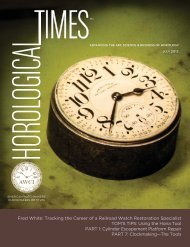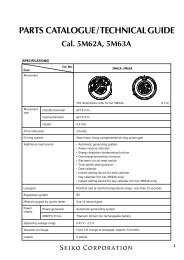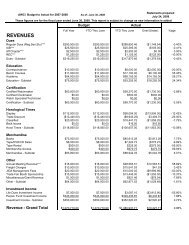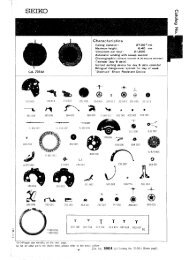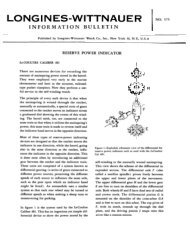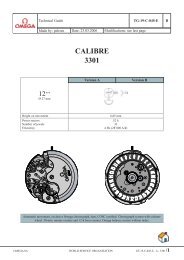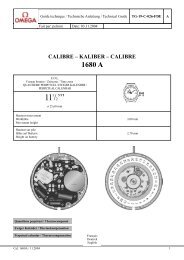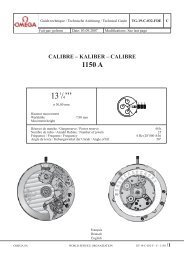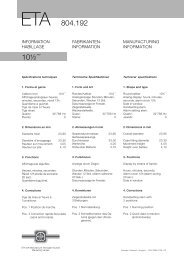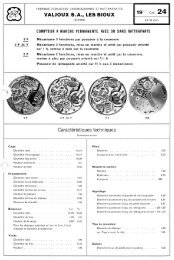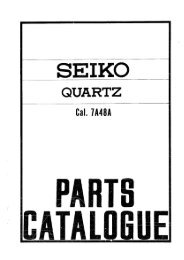PDF Version - The American Watchmakers-Clockmakers Institute
PDF Version - The American Watchmakers-Clockmakers Institute
PDF Version - The American Watchmakers-Clockmakers Institute
You also want an ePaper? Increase the reach of your titles
YUMPU automatically turns print PDFs into web optimized ePapers that Google loves.
Why Spring Bars Are So Important<br />
We all know spring bars as those little<br />
metal springy rods that connect a<br />
watch bracelet or strap to the case.<br />
You often see them in other applications<br />
as well, like buckles, clasps, and even bracelet<br />
links. Costs can vary anywhere from a few cents to<br />
about $50 for 18K gold. While simple in design, they<br />
are very essential. <strong>The</strong>re are many different types of<br />
spring bars serving different applications. <strong>The</strong>refore,<br />
it’s important for us to train counter help, apprentices,<br />
and others on how to choose the right spring<br />
bar for the job.<br />
Good quality spring bars keep the watch from falling<br />
off the customer’s wrist and there are a few things<br />
you should know about them. Using the wrong<br />
spring bar may cause the watch to fall off the strap,<br />
the spring bar to break prematurely,<br />
or may just make it impossible<br />
for the next guy to remove<br />
them without risking damage to<br />
the watch case.<br />
Spring bars come in different diameters<br />
and lengths. You should<br />
always use the largest possible<br />
diameter which will work with the<br />
strap or bracelet. Common sizes<br />
are 1.3mm, 1.5mm and 1.8mm.<br />
Spring bars for Rolex and other<br />
high end brands are sometimes<br />
as big as 2.0mm in diameter. To<br />
determine the right length of the<br />
spring bar, measure the space<br />
between the two lugs with a vernier<br />
caliper or similar device. A<br />
spring bar that is labeled as 15mm<br />
should fit lugs with 15mm between<br />
them. <strong>The</strong> spring bar will be much<br />
larger when expanded, but when<br />
fully compressed it will be slightly<br />
smaller than 15mm. Figure 1<br />
<strong>The</strong> following information will help you choose the<br />
right spring bar for your customer’s watch.<br />
Types of spring bars (Figure 1):<br />
• Double flanged: For use only with lugs whose holes<br />
do not penetrate to the outside of the watch case<br />
(blind holes). <strong>The</strong> function of the second flange is to<br />
allow access to remove the spring bars.<br />
By Jordan ficklin, cmw21<br />
• Shouldered: For use with lugs whose holes penetrate<br />
all the way through. No flange is necessary<br />
because you can push on the tip of the bar through<br />
the hole to remove them. It can be challenging to<br />
remove these from “blind” lug holes because there<br />
is no way to grip the shaft of the bar and compress<br />
the spring. Since the holes pierce the entire lug, the<br />
bars can penetrate deeper providing more support<br />
although the “blind” hole is more aesthetic.<br />
• Clasp bars: <strong>The</strong>se are usually single-flanged but<br />
with a very short tip which will not stick out beyond<br />
the edge of the clasp. In order to have a secure fit,<br />
the diameter of the portion which penetrates the<br />
clasp should be a tight fit; however, this can be difficult<br />
to accommodate when using a generic spring<br />
bar.<br />
Clasp bars with short tips are not<br />
designed to be used to attach the<br />
bracelet or strap to the case because<br />
they provide very little support.<br />
• Curved bars: Some manufacturers<br />
design lugs that require a curved<br />
spring bar to hold the strap to the<br />
case. <strong>The</strong> only advantage in using<br />
a curved bar is aesthetics. Assortments<br />
of curved bars can be purchased.<br />
Additionally, tools which can<br />
place a gentle bend in the straight<br />
bars are available.<br />
• Female bars: <strong>The</strong>se bars have a<br />
cup on the end in place of a post and<br />
are used when the lug has a post<br />
sticking out instead of a hole.<br />
• Lever bars: Lever bars are a fairly<br />
recent invention for use with quick<br />
release or “E-Z fit” straps. High quality<br />
lever bars have a screw which can<br />
be removed and reinserted once the<br />
bar is placed into the strap. Lower<br />
quality bars have a post welded onto the pin in the<br />
bar. In order to insert the bar, the entire bar needs to<br />
pass through the lever slot in the strap. <strong>The</strong>n the pin<br />
is depressed to get the short end through the slot.<br />
<strong>The</strong> spring bars you choose should be made of a<br />
non-corrosive material such as stainless steel. Base<br />
metal spring bars will corrode and break faster. It is<br />
also common practice to use spring bars made of the<br />
Horological Times December 2010 14



